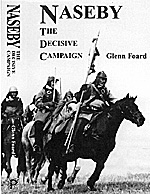
Pryor Publications, 1995.432 pp. 83 illus. and maps, bibliog. £ 22.50
Those of us who have listened to Mr Foard's fascinating lectures on the Naseby Campaign have been awaiting the publication of this book with keen anticipation, and the result is fully up to expectations. "Naseby" is one of the most important contributions to the military history of the English Civil War to appear in the last thirty years.
The author states that "the primary objective of this book is a simple narrative of military events". In fact, he achieves far more than this. Mr Poard is by profession a landscape archaeologist, who uses his expertise to place the battle in its 17th century landscape setting with far gereater accuracy and comprehensiveness than has been achieved with any other Civil War battle.
Of equal importance is the unparalled use (with the incomplete exception of Marston Moor) made of archaeological field work, especially the careful and systematic use of metal detector surveys of the pattern of musket shot in the area. This work, though still incomplete, has revolutionised our picture of the course of the battle.
The author includes invaluable chapters dealing with the contemporary landscape of the area and the background to the war in the region. Whilst not duplicating the work of Peter Young (particularly on the Royalist forces) in his book on Naseby, Mr Foard has much of interest to say on the nature and composition of the rival armies, and cites persuasive evidence to support the growing view that there was not the disparity in numbers between them previously assumed.
Indeed, when the mammoth task of sorting through the vast amount of relevant material in the Public Record Office is ever completed, records may show the New Model at Naseby to have been considerably smaller than hitherto supposed.
The campaign which led up to Naseby is described fully, and much interesting material is included on the impact of the rival armies on the local communities. In general, the evidence suggests that, whilst not blameless, the New Model took considerably more pains to limit the worst effects of its presence in the area, than the King's army did, though, as the author points out, it should be remembered that the Royalists were operating in what they regarded as enemy territory.
The discussion of the battle itself and its preliminaries makes masterly use of all available sources, written, topographical and archaeological, and provides the most detailed and authoritative description and discussion of a Civil War engagement yet to appear. As the author takes pains to point out, some of his findings must remain tentative, hopefully to be clarified by further archaeological and documentary evidence in the future, and as a result some problems remain.
Frontages
A notable example is the vexed question of the frontages of the opposing forces. Though it is possible to reconcile the Royalist deployment with De Comme and Streeters plans, documentary evidence and contemporary drill book recommendations, the same does not apply to the New Model, whose normally accepted numbers would not fit into the clearly defined constraints imposed by the terrain using recommended frontages.
The only solutions appear to be that either the textbooks were ignored on this occasion (and by inference, on others) because of specific tactical and terrain considerations, or, once again, the New Model at Naseby WAS fewer in numbers than usually assumed. Once more, material in the R.R.O. may eventually provide the answer.
The account of the battle itself is clear and impressive (though a minor caveat is that more maps of its later stages would have been useful). It is here that archeological work has transformed our understanding of what actually happened, and superceded all previous accounts of the battle. As the author would accept, there are still relatively minor areas of uncertainty, regarding timings and the exact sequence of some incidents, which future survey work may in some cases clarify, but overall we now have a clearer picture of what happened at Naseby than in any other E.C.W. battle.
The amount of fresh knowledge which the author has brought to light by the research methods employed has far-reaching implications for the whole field of E.C.W. military history and beyond.
Aftermath of Battle
Also included is a comprehensive survey of the aftermath of Naseby, and a fascinating discussion of the changes in the terrain of the battlefield over the succeeding centuries and of the changing role of Naseby in the national psyche. Also included is a fascinating survey of the chequered fortunes of various battlefield relics.
Though it is cheering to learn that the controversial motorway extension seems in fact to have virtually all of the battlefield proper unscathed, such a result owes more to luck than judgement, and Mr Foard rightly enters a plea for the urgent need to recognise the importance of systematic battlefield exploration, interpretation, preservation and presentation.
The book is copiously illustrated, though it might have been useful to have included some modern photographs of the battlefield in place of a few of the 18th century engravings of less immediate relevance.
Overall, this book cannot be praised too highly; it revolutionises the study of E.C.W. military history, and so far as Naseby is concerned, is unlikely ever to be superceded. Mr Foard sets the standard which future battlefield studies will have to meet. A "classic" piece of research, to be ranked for its influence alongside such titles as Peter Young's "Edgehill", "Naseby" is an essential item for every E.C.W. book collection, which will be read, discussed and referred to again and again. Buy it!
Back to English Civil War Times No. 52 Table of Contents
Back to English Civil War Times List of Issues
Back to Master Magazine List
© Copyright 1997 by Partizan Press
This article appears in MagWeb (Magazine Web) on the Internet World Wide Web.
Other military history articles and gaming articles are available at http://www.magweb.com